



Featured image: Image from “Otherworldly” at Manchester Urban Screens 2007. Curated by Michelle Kasprzak
Eva Kekou interviews Michelle Kasprzak, a Canadian curator and writer based in Amsterdam, the Netherlands. She is a Curator at V2_ Institute for the Unstable Media and the Dutch Electronic Art Festival (DEAF). She has appeared in Wired UK, on radio and TV broadcasts by the BBC and CBC, and lectured at PICNIC. In 2006 she founded Curating.info, the web’s leading resource for curators. She has written critical essays for C Magazine, Volume, Spacing, Mute, and many other media outlets. She is a member of IKT (International Association of Curators of Contemporary Art). Michelle is also an avid weightlifter with current personal records of 80 kg squat, 52.5 kg bench press, and 90 kg deadlift.
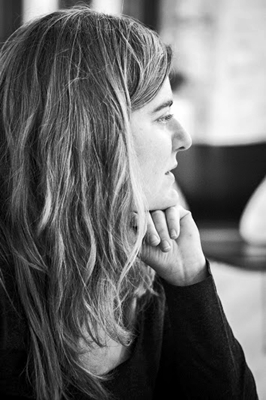
Eva Kekou: Can you give us some info about your work as an artist and curator and specifically your work at V2_?
Michelle Kasprzak: I was trained as an artist, but my art career feels many moons ago now. My first love was photography, and I spent many hours in the darkroom as a teenager. Later on I moved into live video mixing for performance contexts and parties, single channel video works, and integrating technologies like speech recognition and found objects into performance.

I was also curating throughout this time, though for many years it took a back seat to my artistic practice. Eventually I realized that I was more interested in curating and writing than making the artworks myself. Of course, one should never say never, so I may return to art making someday, but from that point onward and until the present time I focused full-time on curating and writing.
This was the mid 2000s and it was a pretty exciting time to be a media arts curator. It felt as though things were gaining traction. So many years after Cybernetic Serendipity had laid the foundations, we had exhibitions such as The Art Formerly Known As New Media curated by Sarah Cook and Steve Dietz to stimulate the dialogue about new media art and how to exhibit it, and take it all to the next level.
Fast forward to now: a few years later, I’m a curator at V2_ Institute for the Unstable Media in Rotterdam, the Netherlands. V2_ loomed large for me as a young undergraduate in Toronto studying new media – it was this far away place in a city I didn’t know with this massive reputation for doing edgy, interesting things. I wouldn’t in my wildest dreams at the time ever imagine I would one day work there.
As an institute, V2_ has been through a number of key transformations and I think it’s interesting to map that on to what was happening at the time both in art and in society. It started in the 1981 as a squat (which was common in the Netherlands at that time) and the founders called it a “multimedia centre”. Sonic Youth, Laibach, and Einsturzende Neubauten played there. The “Manifesto for the Unstable Media” was written in 1987 and arose out of a dissatisfaction with the status quo and it said things like “Our goal is to strive for constant change”. Following the Manifesto, a series of “Manifestations of the Unstable Media” were created, which evolved into the Dutch Electronic Art Festival (DEAF), a festival which continues today. In 1994 V2_ moved from s-Hertogenbosch to Rotterdam and has remained there ever since.
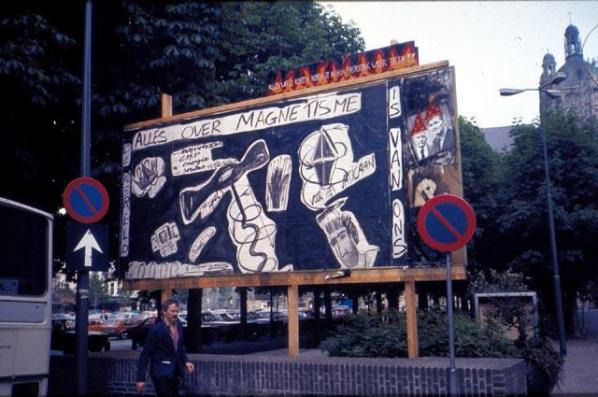
Around that same period of the mid- to late-90s, the growth of internet access and support for artists working with networked technologies caused V2_ to change its focus in this direction. In 1997, V2_Lab opened as a hub within V2_ to initiate and support the production of artistic projects investigating contemporary issues in art, science, technology, and society.
EK: So today, in this age of ubiquitous technology and information, where does an institute like V2_ find its place?
MK: I see media art as a category splintering and dissolving, with bits of its ethos absorbed into design, contemporary art, craft, and hacker culture – and vice versa. One way to find a place in the world is to stay true to the origins of V2_ in terms of its squatter ethic. So for example, we (myself and my colleagues, particularly Boris Debackere and Michel van Dartel) recently rewrote the mission statement of the Lab, declaring it “…an autonomous zone where experiments and collaborations can take place outside of the constraints of innovation agendas or economic and political imperatives.” Which is not to say that anything goes, but states explicitly that we’re especially open to people looking for a home for a risky or unconventional idea. Also, following on from several years where V2_Lab hosted residents based on three fairly technologically-driven themes (wearables, augmented reality, and ecology), the Lab has taken on a new direction of being methodologically-driven, and looking at themes like re-enactments, design fiction, and extreme scenarios.
I think it’s a key shift, because in order to “strive for constant change” as we said in the original manifesto, linking to any one technology of the moment seems too static and limiting, as well as reducing our reach into areas with interesting and relevant artistic research occurring, but which might not have much technology involved in an apparent way. The fact is just about everything being made right now is a product of the technological age we live in, so it’s more useful to think in terms of methods and approaches rather than whether something fits a classic definition of what media art is or not.
Take for example one of our latest commissions, Paper Moon by Ilona Gaynor in collaboration with Craig Sinnamon. Ilona and Craig were at V2_ for a few months at the end of 2013 and both have design backgrounds. The work, to describe it in a formal sense, is a series of objects and paper-based work arranged in a specific fashion along with a short screen-based animation. This seems a little different than what one might expect to see at V2_, except for small clues in the creation of some of the items (the animation is generated with 3D animation software, some of the objects have been 3D printed). But more significantly, in its thematic Paper Moon enters the realm of the unstable by exploring the emerging legal definitions and loopholes of outer space – particularly the treatment of the moon and other celestial bodies. Our legal system on Earth, as Ilona put it “…has no definition for what ‘Outer Space’ actually means, what it is, and where it is. The problem we face with such literal unmarked territory is the emergent field of ‘Space Law’ becomes genuinely speculative.”


Ilona’s residency was part of V2_Lab research project Habbakuk, about Innovation in Extreme Scenarios. The Innovation in Extreme Scenarios research thread was generated in reaction to the introduction of an innovation agenda for the arts as part of the Dutch government’s ambitionto be “one of the world’s top five knowledge economies” by 2020. As a way of directly addressing this policy direction, V2_Lab began undertaking research into the nature of and appropriate contexts for innovation through a series of expert meetings, workshops, site visits and interviews over the course of 2013-14. The final outputs of the project, which will comprise project commissions and a final publication, will be used as a tool to engage with the policy conversation on innovation in a more profound way. So we’ve been doing work on this at home and abroad, holding expert meetings and interviews in the Netherlands, Canada, Hungary, and Denmark.
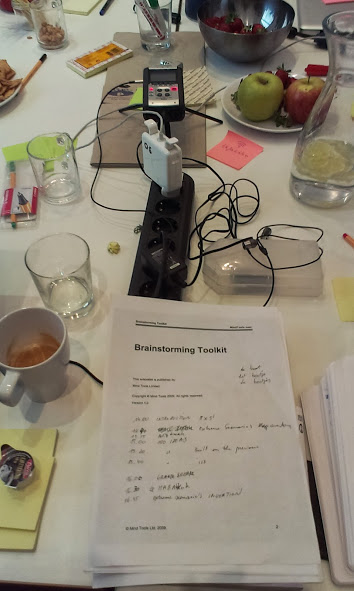
The Dutch policy context explains the “innovation” part, but the “extreme scenarios” part came from somewhere else. For that I was inspired by the World War II story of the Habbakuk aircraft carrier which was commissioned by Winston Churchill. The Allies were plagued by German U-boats, and Churchill desperately needed an innovative solution to this particular problem. In the extreme scenario of war, Churchill authorized the production of a radically innovative solution: building an aircraft carrier made of ice – specifically Pykrete, a frozen mixture of water and sawdust.
Pykrete seems like ordinary ice but the addition of sawdust makes it into a kind of wonder material that takes longer to melt and invulnerable to bullets. In the end the massive ship, which was to be christened “Habbakuk”, never saw the theatre of war but considerable effort was put into developing a prototype in total secrecy deep in the Canadian Rockies.
Inspired by both the Habbakuk story and our own policy situation brewing at home, some of the questions we’ve been trying to answer with this research are things like: What are the best contexts for innovation to take place? What are the myths surrounding how innovation occurs? Does the pressure of an extreme scenario inspire innovative solutions, or only eccentric, unrealisable concepts? What’s the U-boat problem of today?
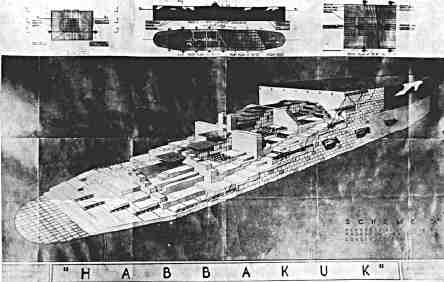
The theme of Innovation in Extreme Scenarios is also being explored in the programme that I devised and curate at V2_ called Blowup. Blowup refers to a number of things: the way that you can blow up a photograph, a balloon, a situation, and of course – the Antonioni film. I see it as a container that presents things in a slightly different way each time, and that its main remit is to examine the things that are changing the way we live now, or reinforcing the status quo of today. The formats for Blowup have varied a lot: from a workshop, to a talk show, to a talk show within a talk show, to a five day booksprint, to an exhibition in a pop-up space. The topics have been equally eclectic: art for animals, outer space, journalism as an art practice, object-oriented ontology, and so on. The most consistent element is that each event has an eBook released along with it, and that these eBooks explore the topic in a little more depth, but also combine previously released material with newly commissioned material. We all have bulging bookshelves and intend to always read something later – by bringing relevant old texts back into the forefront, I hope to give them a chance for a second look (or a first look if you missed it when it was released).
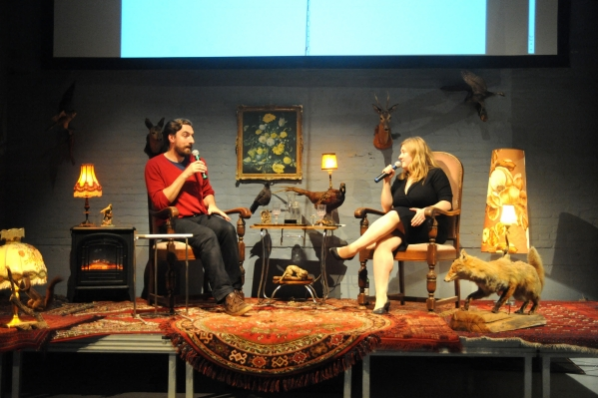
EK: What are your hopes and dreams for the future?
MK: For the future, I think new ideas are incredibly rare, and that doesn’t bother me at all – what interests me is that dreams that were previously impossible are becoming possible, and so my passion continues to be seeking out the inventive eccentrics with grand master plans, and being a part of realising that. Churchill dreamed of ending the war with a boat made of ice more than ten times the size of the Queen Mary. These are the kinds of big wild dreams – in scale and in scope, if not in my discipline – that I dream of.
Jonas Lund’s artistic practice revolves around the mechanisms that constitute contemporary art production, its market and the established ‘art worlds’. Using a wide variety of media, combining software-based works with performance, installation, video, photography and sculptures, he produces works that have an underlying foundation in writing code. By approaching art world systems from a programmatic point of view, the work engages through a criticality largely informed by algorithms and ‘big data’.
It’s been just over a year since Lund began his projects that attempt to redefine the commercial art world, because according to him, ‘the art market is, compared to other markets, largely unregulated, the sales are at the whim of collectors and the price points follows an odd combination of demand, supply and peer inspired hype’. Starting with The Paintshop.biz (2012) that showed the effects of collaborative efforts and ranking algorithms, the projects moved closer and closer to reveal the mechanisms that constitute contemporary art production, its market and the creation of an established ‘art world’. Its current peak was the solo exhibition The Fear Of Missing Out, presented at MAMA in Rotterdam.
Annet Dekker: The Fear Of Missing Out (FOMO) proposes that it is possible to be one step ahead of the art world by using well-crafted algorithms and computational logic. Can you explain how this works?
Jonas Lund The underlying motivation for the work is treating art worlds as networked based systems. The exhibition The Fear Of Missing Out spawned from my previous work The Top 100 Highest Ranked Curators In The World, for which I assembled a comprehensive database on the bigger parts of the art world using sources such as Artfacts, Mutaul Art, Artsy and e-flux. The database consists of artists, curators, exhibitions, galleries, institutions, art works and auction results. At the moment it has over four million rows of information. With this amount of information – ‘big data’ – the database has the potential to reveal the hidden and unfamiliar behaviour of the art world by exploring the art world as any other network of connected nodes, as a systemic solution to problematics of abstraction.
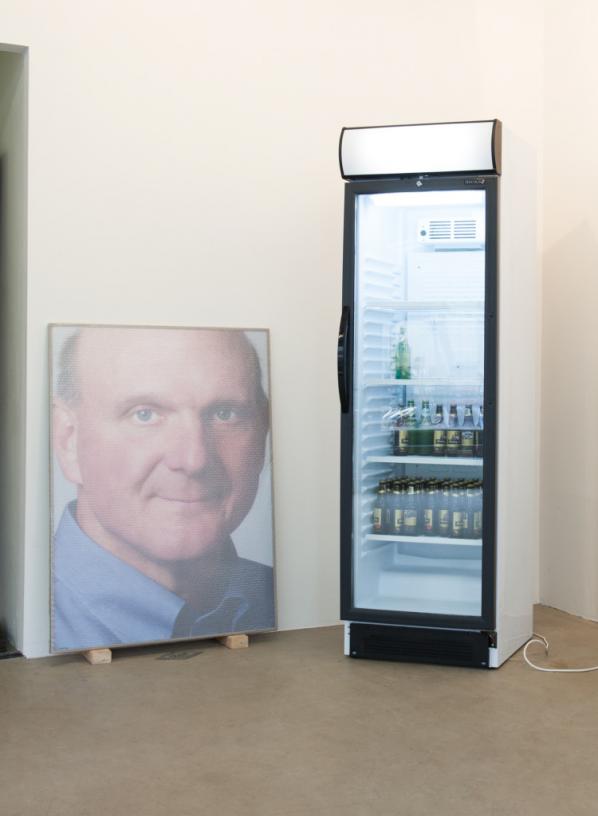
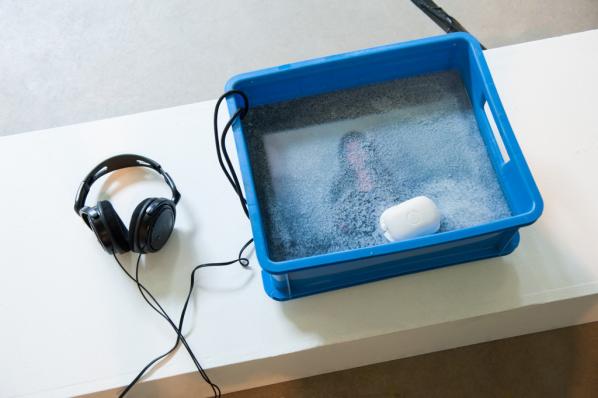
In The Top 100 Highest Ranked Curators In The World, first exhibited at Tent in Rotterdam, I wrote a curatorial ranking algorithm and used the database, to examine the underlying stratified network of artists and curators within art institutions and exhibition making: the algorithm determined who were among the most important and influential players in the art world. Presented as a photographic series of portraits, the work functions both as a summary of the increasingly important role of the curator in exhibition making, as an introduction to the larger art world database and as a guide for young up and coming artists for who to look out for at the openings.
Central to the art world network of different players lies arts production, this is where FOMO comes is. In FOMO, I used the same database as the basis for an algorithm that generated instructions for producing the most optimal artworks for the size of the Showroom MAMA exhibition space in Rotterdam while taking into account the allotted production budget. Prints, sculptures, installations and photographs were all produced at the whim of the given instructions. The algorithm used meta- data from over one hundred thousand art works and ranked them based on complexity. A subset of these art works were then used, based on the premise that a successful work of art has a high price, high aesthetic value but low production cost and complexity, to create instructions deciding title, material, dimensions, price, colour palette and position within the exhibition space.
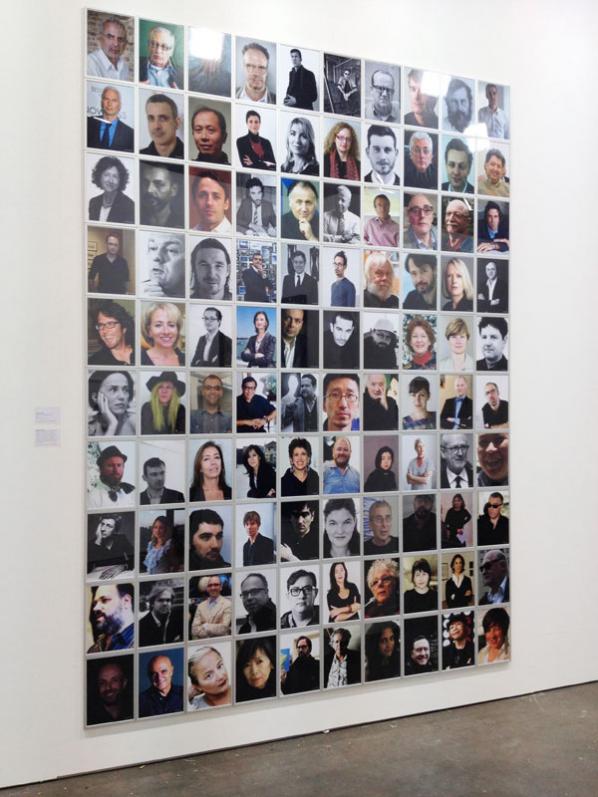
Similar to how we’re becoming puppets to the big data social media companies, so I became a slave of the instructions and executed them without hesitation. FOMO proposes that it is possible to be one step ahead of the art world by using well-crafted algorithms and computational logic and questions notions of authenticity and authorship.
AD: To briefly go into one of the works, in an interview you mention Shield Whitechapel Isn’t Scoop – a rope stretched vertically from ceiling to floor and printed with red and yellow ink – as a ‘really great piece’, can you elaborate a little bit? Why is this to you a great piece, which, according to your statement in the same interview, you would not have made if it weren’t the outcome of your analysis?
JL: Coming from a ‘net art’ background, most of the previous works I have made can be simplified and summarised in a couple of sentences in how they work and operate. Obviously this doesn’t exclude further conversation or discourse, but I feel that there is a specificity of working and making with code that is pretty far from let’s say, abstract paintings. Since the execution of each piece is based on the instructions generated by the algorithm the results can be very surprising.
The rope piece to me was striking because as soon as I saw it in finished form, I was attracted to it, but I couldn’t directly explain why. Rather than just being a cold-hearted production assistant performing the instructions, the rope piece offered a surprise aha moment, where once it was finished I could see an array of possibilities and interpretations for the piece. Was the aha moment because of its aesthetic value or rather for the symbolism of climbing the rope higher, as a sort of contemporary art response to ‘We Started From The Bottom Now We’re Here’. My surprise and affection for the piece functions as a counterweight to the notion of objective cold big data. Sometimes you just have to trust the instructionally inspired artistic instinct and roll with it, so I guess in that way maybe now it is not that different from let’s say, abstract painting.
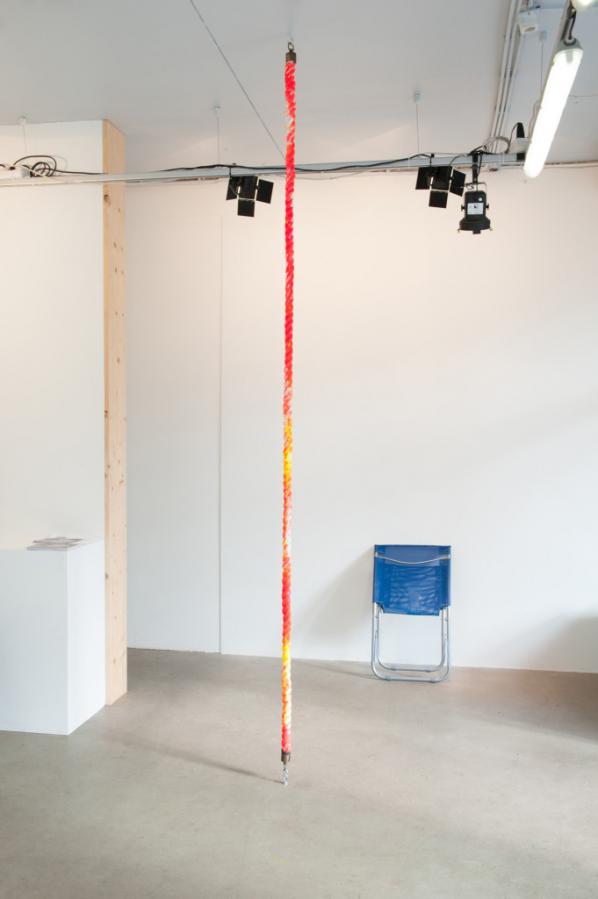
AD: I can imagine quite a few people would be interested in using this type of predictive computation. But since you’re basing yourself on existing data in what way does it predict the future, is it not more a confirmation of the present?
JL: One of the only ways we have in order to make predictions is by looking at the past. Through detecting certain patterns and movements it is possible to glean what will happen next. Very simplified, say that artist A was part of exhibition A at institution A working with curator A in 2012 and then in 2014 part of exhibition B at institution B working with curator A. Then say that artist B participates in exhibition B in 2013 working with curator A at institution A, based on this simplified pattern analysis, artist B would participate in exhibition C at institution B working with curator A. Simple right?
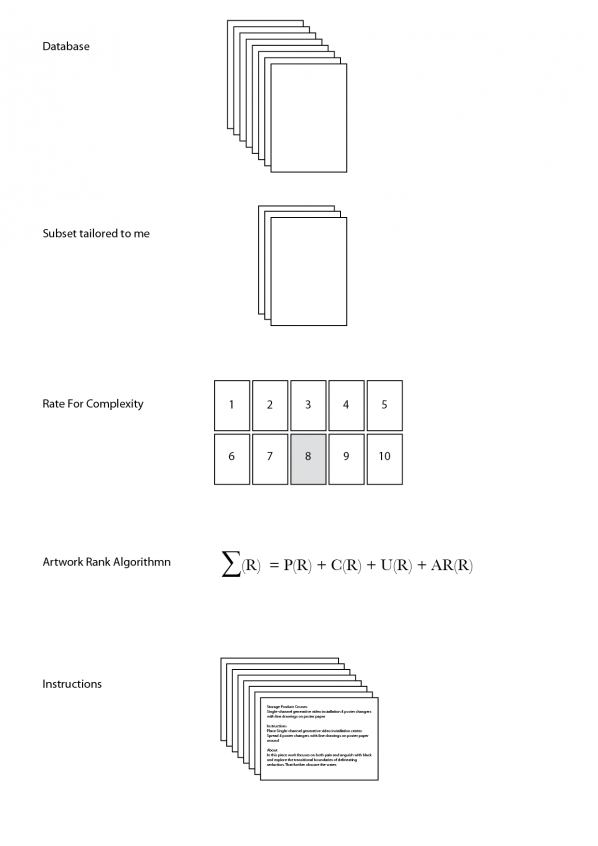
AD: In the press release it states that you worked closely with Showroom MAMA’s curator Gerben Willers. How did that relation give shape or influenced the outcome? And in what way has he, as a curator, influenced the project?
JL: We first started having a conversation about doing a show in the Summer of 2012, and for the following year we met up a couple of times and discussed what would be an interesting and fitting show for MAMA. In the beginning of 2013 I started working with art world databases, Gerben and I were making our own top lists and speculative exhibitions for the future. Indirectly, the conversations led to the FOMO exhibition. During the two production phases, Gerben and his team were immensely helpful in executing the instructions.
AD: Notion of authorship and originality have been contested over the years, and within digital and networked – especially open source – practices they underwent a real transformation in which it has been argued that authorship and originality still exist but are differently defined. How do see authorship and originality in relation to your work, i.e. where do they reside; is it the writing of the code, the translation of the results, the making and exhibiting of the works, or the documentation of them?
JL: I think it depends on what work we are discussing, but in relation to FOMO I see the whole piece, from start to finish as the residing place of the work. It is not the first time someone makes works based on instructions, for example Sol LeWitt, nor the first time someone uses optimisation ideas or ‘most cliché’ art works as a subject. However, this might be first time someone has done it in the way I did with FOMO, so the whole package becomes the piece. The database, the algorithm, the instructions, the execution, the production and the documentation and the presentation of the ideas. That is not to say I claim any type of ownership or copyright of these ideas or approaches, but maybe I should.
AD: Perhaps I can also rephrase my earlier question regarding the role of the curator: in what way do you think the ‘physical’ curator or artist influences the kind of artworks that come out? In other words, earlier instructions based artworks, like indeed Sol LeWitt’s artworks, were very calculated, there was little left to the imagination of the next ‘executor’. Looking into the future, what would be a remake of FOMO: would someone execute again the algorithms or try to remake the objects that you created (from the algorithm)?
JL: In the case with FOMO the instructions are not specific but rather points out materials, and how to roughly put it together by position and dimensions, so most of the work is left up to the executor of said instructions. It would not make any sense to re-use these instructions as they were specifically tailored towards me exhibiting at Showroom MAMA in September/October 2013, so in contrast to LeWitt’s instructions, what is left and can travel on, besides the executions, is the way the instructions were constructed by the algorithm.
AD: Your project could easily be discarded as confirming instead of critiquing the established art world – this is reinforced since you recently attached yourself to a commercial gallery. In what way is a political statement important to you, or not? And how is that (or not) manifested most prominently?
JL: I don’t think the critique of the art world is necessarily coming from me. It seems like that is how what I’m doing is naturally interpreted. I’m showing correlations between materials and people, I’ve never made any statement about why those correlations exist or judging the fact that those correlations exist at all. I recently tweeted, ‘There are three types of lies: lies, damned lies and Big Data’, anachronistically paraphrasing Mark Twain’s distrust for the establishment and the reliance on numbers for making informed decisions (my addition to his quote). Big data, algorithms, quantification, optimisation… It is one way of looking at things and people; right now it seems to be the dominant way people want to look at the world. When you see that something deemed so mysterious as the art world or art in general has some type of structural logic or pattern behind it, any critical person would wonder about the causality of that structure, I guess that is why it is naturally interpreted as an institutional critique. So, by exploring the art world, the market and art production through the lens of algorithms and big data I aim to question the way we operate within these systems and what effects and affects this has on art, and perhaps even propose a better system.
AD: How did people react to the project? What (if any) reactions did you receive from the traditional artworld on the project?
JL: Most interesting reactions usually take place on the comment sections of a couple of websites that published the piece, in particular Huffington Post’s article ‘Controversial New Project Uses Algorithm To Predict Art’. Some of my favourite responses are:
‘i guess my tax dollars are going to pay this persons living wages?’
‘Pure B.S. ……..when everything is art then there is no art’
‘As an artist – I have no words for this.’
‘Sounds like a great way to sacrifice your integrity.’
‘Wanna bet this genius is under 30 and has never heard of algorithmic composition or applying stochastic techniques to art production?’
‘Or, for a fun change of pace, you could try doing something because you have a real talent for it, on your own.’
AD: Even though the project is very computational driven, as you explain the human aspects is just as important. A relation to performance art seems obvious, something that is also present in some of your other works most notably Selfsurfing (2012) where people over a 24 hour period could watch you browsing the World Wide Web, and Public Access Me (2013), an extension of Selfsurfing where people when logged in could see all your online ‘traffic’. A project that recalls earlier projects like Eva & Franco Mattes’ Life Sharing (2000). In what way does your project add to this and/or other examples from the past?


JL: Web technology changes rapidly and what is possible today wasn’t possible last year and while most art forms are rather static and change slowly, net art in particular has a context that’s changing on a weekly basis, whether there is a new service popping up changing how we communicate with each other or a revaluation that the NSA or GCHQ has been listening in on even more facets of our personal lives. As the web changes, we change how we relate to it and operate within it. Public Access Me and Selfsufing are looking at a very specific place within our browsing behaviour and breaks out of the predefined format that has been made up for us.
There are many works within this category of privacy sharing, from Kyle McDonalds’ live tweeter, to Johannes P Osterhoff’s iPhone Live and Eva & Franco Mattes’ earlier work as you mentioned. While I cannot speak for the others, I interpret it as an exploration of a similar idea where you open up a private part of your daily routine to re-evaluate what is private, what privacy means, how we are effected by surrendering it and maybe even simultaneously trying to retain or maintain some sense of intimacy. Post-Snowden, I think this is something we will see a lot more of in various forms.
AD: Is your new piece Disassociated Press, following the 1970s algorithm that generated text based on existing texts, a next step in this process? Why is this specific algorithm of the 70s important now?

JL: Central to the art world lies e-flux, the hugely popular art newsletter where a post can cost up to one thousand dollars. While spending your institution’s money you better sound really smart and using a highly complicated language helps. Through the course of thousands of press releases, exhibition descriptions, artist proposals and curatorial statements a typical art language has emerged. This language functions as a way to keep outsiders out, but also as a justification for everything that is art.
Disassociated Press is partly using the Dissociated Press algorithm developed in 1972, first associated with the Emacs implementation. By choosing a n-gram of predefined length and consequently looking for occurrences of these words within the n-gram in a body of text, new text is generated that at first sight seems to belong together but doesn’t really convey a message beyond its own creation. It is a summary of the current situation of press releases in the international English art language perhaps, as a press release in its purest form. So, Disassociated Press creates new press releases to highlight the absurdity in how we talk and write about art. If a scrambled press release sounds just like normal art talk then clearly something is wrong, right?